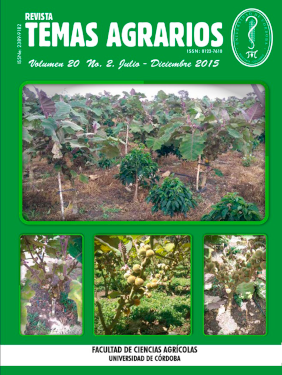Development of polyurethanes with phytoavailable boron retention capacity
Desarrollo de poliuretanos con capacidad de retención de boro fiodisponible
How to Cite
Palencia, M., Afanasjeva, N., & Benavidez, E. (2015). Development of polyurethanes with phytoavailable boron retention capacity. Sour Topics, 20(2), 49-57. https://doi.org/10.21897/rta.v20i2.758
Dimensions
license

This work is licensed under a Creative Commons Attribution-NonCommercial 4.0 International License.
Show authors biography
Article visits 816 | PDF visits
Downloads
Download data is not yet available.
- Abu-Sharar, T. Bani, N.and Al-Khader, S. 2014. Boron adsorption–desorption characteristics of irrigated soils in the Jordan Valley. Geoderma Regional, (2), p50-59.
- Ahmad, W., Zia, M., Malhi, S. and Niaz, A. 2012. Boron Defiiency in soils and crops: a review. Crop Plant, p77-114.
- Blevins, D. and Lukaszewski, K. 1998. Boron in plant structure and function, Annual Reviews Plant Physiology Plant Molecular Biology 49(1):481–500.
- Handreck, K. 1990. Methods of assessing boron availability in potting media with special reference to toxicity. Communication in Soil Science Plant Analysis. 21(19-20): 2265-2280.
- Hu, H., Brown, P. and Labavitch, J. 1996. Species variability in boron requirements is correlated with cell wall pectin. Journal Experimental Botany 47(2): 227-232.
- Janik, H. and Marzec, M. 2015. A review: Fabrication of porous polyurethane scaffolds. Materials Science and Engineering: C. 48:586-591.
- Kot, F. 2015. Boron in the Environment. Boron Separation Processes. Elsevier. p 1-33.
- Lvov, Y. and Abdullayev, E. 2013. Functional polymer–clay nanotube composites with sustained release of chemical agentss. Progress in Polymer Science, 38(10):1690-1719.
- Majidi, A., Rahnemaie, R., Hassani, A. and Malakouti M. 2010. Adsorption and desorption processes of boron in calcareous soils. Chemosphere, 80(7): 733-739.
- Navarro, S. y Navarro, G. 2003. Química agrícola: El suelo y los elementos químicos esenciales para la vida vegetal. 2a ed. Mundi-prensa, Barcelona. 487 p.
- Palencia, M., Vera, M. and Rivas B. 2014. Modifiation of ultrafitration via membranes interpenetrating polymer networks for removal of boron from aqueous solution. Journal Membrane Science 466:192-199.
- Palencia, M., Vera, M. and Combatt, E. 2014. Polymer network based in (4-vinylbenzyl)-N-metil-D-glucaminesuppourted on microporous polypropylene layers with retention boron capacity. Journal Applied Polymer Science 131(16):40653-40660.
- Penagos, D., Restrepo, H. and Palencia, M. 2015. Grafting Polymer Based in Active Polyurethane Matrixes Via Free Radical. Procedia Materials Science 9:491-495.
- Polat, H., Vengosh, A., Pankratov, I. and Polat, M. 2004. A new methodology for removal of boron from water by coal and fl ash, Desalination, 164(2):173-188.
- Reid, R. 2010. Can we really increase yields by making crop plants tolerant to boron toxicity?.PlantScience, 178(1):9-11.
- Rivas, B., Pereira, E., Palencia, M. and Sánchez, J. 2011. Water-soluble functional polymers in conjunction with membranes to remove pollutant ions from aqueous solutions, Progress in Polymer Science, 36(2):294-322.
- Roig-Navarro, A., López, F. and Hernández, F. 1996. Application of azomethine-H method to the determination of boron in workplace atmospheres from ceramic factories, Journal of Analytical Chemistry, 356(1):103-106.
- Sah, R. and Brown, P. 1997. Boron determination - a review of analytical methods. Microchemical Journal, 56(3):285-304.
- Ulbricht, U. 2006. Advanced functional polymer membranes, Polymer 47(7):2217-262.
- Urbano, B. and Rivas, B. 2012. Water-insoluble nanocomposite ion exchange resin based on N-methyl-D-glucamine ligand groups for arsenic removal. Reactive FunctionalPolymer, 72(9) :642-649.
- Vera, M., Combatt, E. y Palencia, M. 2014. Estudio de la capacidad de retención de boro disponible en suelos mediante membranas funcionales con cadenas de polioles. Temas Agrarios 19 (1):96-105.




















